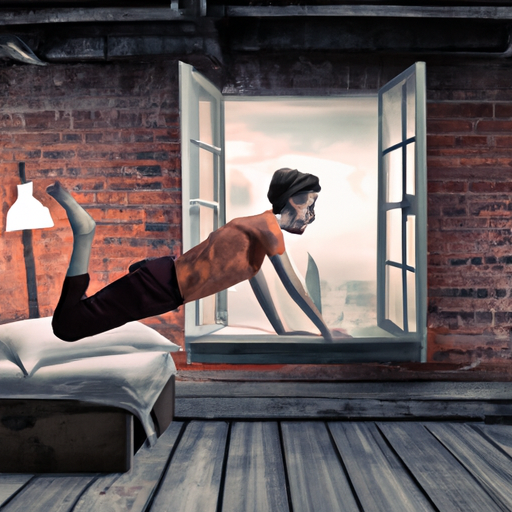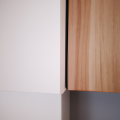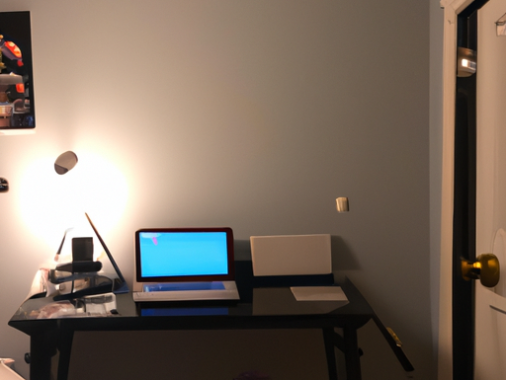-
Table of Contents
- Introduction
- The Pros and Cons of Putting Your Bed Under a Window
- How to Maximize Comfort and Privacy When Your Bed is Under a Window
- The Health Risks of Sleeping Under a Window
- How to Block Out Light and Noise When Your Bed is Under a Window
- How to Make the Most of a Bed Under a Window
- Creative Solutions for Making a Bed Under a Window Work
- How to Choose the Right Window Treatments for a Bed Under a Window
- Q&A
- Conclusion
Introduction
When it comes to bedroom design, one of the most important decisions you can make is where to place your bed. While it may seem like a good idea to put your bed under a window, there are several reasons why this is not a good idea. Not only can it be uncomfortable, but it can also be a safety hazard. In this article, we will discuss why you should not put your bed under a window and provide some alternative solutions.
The Pros and Cons of Putting Your Bed Under a Window
Putting your bed under a window can be a great way to maximize space in a small bedroom, but it can also have some drawbacks. This article will discuss the pros and cons of putting your bed under a window.
Pros
One of the main advantages of putting your bed under a window is that it can help to maximize the space in a small bedroom. By placing the bed under the window, you can free up more floor space for other furniture or activities. Additionally, the natural light that comes in through the window can make the room feel more open and airy.
Another benefit of putting your bed under a window is that it can provide a great view. If you have a window that overlooks a beautiful landscape or cityscape, you can enjoy the view from the comfort of your bed.
Cons
One of the main drawbacks of putting your bed under a window is that it can be drafty. If the window is not properly sealed, cold air can come in through the window and make the room uncomfortable. Additionally, if the window is not properly insulated, it can be noisy when it rains or when the wind blows.
Another potential issue with putting your bed under a window is that it can be difficult to get a good night’s sleep. If the window is not properly shaded, the light from the window can be disruptive and make it difficult to sleep.
In conclusion, putting your bed under a window can be a great way to maximize space in a small bedroom, but it can also have some drawbacks. It is important to consider the pros and cons before deciding if this is the right option for you.
How to Maximize Comfort and Privacy When Your Bed is Under a Window
When your bed is placed under a window, it can be difficult to achieve both comfort and privacy. However, there are several steps you can take to maximize both.
First, consider the type of window covering you use. Heavy curtains or blinds can provide a great deal of privacy, while still allowing natural light to enter the room. If you prefer a lighter window covering, you can opt for a sheer curtain or a light-filtering blind. This will provide some privacy while still allowing natural light to enter the room.
Second, consider the placement of your bed. If possible, try to position your bed away from the window, so that you are not directly exposed to the light. This will help to create a more comfortable sleeping environment.
Third, consider the type of bedding you use. If you are using a mattress and box spring, you may want to invest in a mattress pad or topper to provide additional cushioning and insulation. This will help to reduce the amount of light that enters the room and make the bed more comfortable.
Finally, consider the type of furniture you use in the room. If you have a dresser or other furniture near the window, you can use it to block out some of the light. This will help to create a more private sleeping environment.
By following these steps, you can maximize both comfort and privacy when your bed is placed under a window. With the right window covering, bed placement, bedding, and furniture, you can create a comfortable and private sleeping environment.
The Health Risks of Sleeping Under a Window
Sleeping under a window can be a pleasant experience, as it can provide a cool breeze and natural light. However, there are potential health risks associated with sleeping in this position.
One of the primary risks of sleeping under a window is exposure to allergens. Pollen, dust, and other airborne particles can enter through the window and settle on bedding and furniture. This can trigger allergies and asthma symptoms, such as sneezing, coughing, and difficulty breathing. Additionally, if the window is open, insects can enter the room and cause further irritation.
Another potential risk of sleeping under a window is exposure to noise. If the window is located near a busy street or other noisy area, the sound of traffic or other noises can disrupt sleep. This can lead to fatigue, difficulty concentrating, and other health issues.
Finally, sleeping under a window can also increase the risk of exposure to cold temperatures. If the window is not properly insulated, cold air can enter the room and cause discomfort. This can lead to a decrease in sleep quality and an increased risk of illness.
In conclusion, while sleeping under a window can be a pleasant experience, it is important to be aware of the potential health risks associated with this position. Allergens, noise, and cold temperatures can all disrupt sleep and lead to health issues. Therefore, it is important to take steps to reduce these risks, such as using air filters, soundproofing the room, and insulating the window.
How to Block Out Light and Noise When Your Bed is Under a Window
If your bed is situated under a window, it can be difficult to block out light and noise. Fortunately, there are several strategies you can use to reduce the amount of light and noise that enters your bedroom.
First, consider investing in blackout curtains or shades. These window treatments are designed to block out light and noise, and they come in a variety of styles and colors to suit any decor. If you don’t want to invest in blackout curtains, you can also use heavy curtains or drapes to block out light and noise.
Second, you can use soundproofing materials to reduce noise. Soundproofing materials, such as acoustic foam, can be used to line the walls and windows of your bedroom to reduce noise. You can also use rugs and carpets to absorb sound and reduce noise levels.
Finally, you can use white noise machines to mask outside noise. White noise machines generate a low-level sound that can help to block out other noises. You can also use a fan or air purifier to generate a low-level sound that can help to block out noise.
By using these strategies, you can effectively block out light and noise when your bed is situated under a window. With the right window treatments, soundproofing materials, and white noise machines, you can create a peaceful and comfortable sleeping environment.
How to Make the Most of a Bed Under a Window
Creating a comfortable and stylish bedroom is a great way to make your home feel inviting and cozy. If you have a bed under a window, you can make the most of this space by taking advantage of the natural light and creating a unique design. Here are some tips for making the most of a bed under a window.
1. Choose the Right Bed Frame: When selecting a bed frame for a bed under a window, look for one that is low to the ground and has a headboard that is not too tall. This will help to maximize the amount of natural light that comes in through the window.
2. Utilize the Window: Make sure to take advantage of the window by hanging curtains or blinds that can be opened and closed to control the amount of light that comes in. This will also help to create a cozy atmosphere in the room.
3. Add a Reading Nook: If you have a large window, you can create a cozy reading nook by adding a comfortable chair or bench and some pillows. This will make the space more inviting and provide a great spot to relax and read.
4. Add a Headboard: If you don’t have a headboard, consider adding one to the bed. This will help to create a more finished look and provide a place to lean against when reading or watching TV.
5. Add a Rug: Adding a rug to the floor will help to define the space and make it feel more inviting. Choose a rug that is large enough to fit the entire area around the bed.
By following these tips, you can make the most of a bed under a window and create a cozy and inviting bedroom. With the right furniture and accessories, you can create a space that is both stylish and comfortable.
Creative Solutions for Making a Bed Under a Window Work
Making a bed under a window can be a tricky task, but with a few creative solutions, it can be done. Here are some tips to help you make the most of the space:
1. Choose the Right Bed: When selecting a bed for a windowed area, look for one that is low to the ground and has a headboard that is not too tall. This will help to ensure that the bed does not block the window or take up too much space.
2. Utilize Wall Space: If the bed is placed directly under the window, consider using the wall space above the bed for storage. Shelves, cabinets, and other wall-mounted storage solutions can help to maximize the space and keep the area organized.
3. Add a Bench: If the bed is placed away from the window, consider adding a bench or other seating option at the foot of the bed. This will provide a comfortable spot to sit and enjoy the view from the window.
4. Hang Curtains: If the bed is placed directly under the window, consider hanging curtains to provide privacy and block out light. This will also help to create a cozy atmosphere in the room.
By following these tips, you can make a bed under a window work in any space. With a little creativity and planning, you can create a comfortable and stylish bedroom that makes the most of the available space.
How to Choose the Right Window Treatments for a Bed Under a Window
When selecting window treatments for a bed under a window, there are several factors to consider. First, the type of window treatment should be chosen based on the desired level of privacy and light control. For example, if privacy is a priority, then curtains or blinds may be the best option. If light control is the main concern, then shades or shutters may be the best choice.
Second, the size of the window should be taken into account. If the window is large, then heavier window treatments such as curtains or drapes may be necessary to provide adequate coverage. If the window is small, then lighter window treatments such as shades or blinds may be sufficient.
Third, the style of the window treatment should be chosen to complement the existing decor. For example, if the room has a modern aesthetic, then sleek, contemporary window treatments may be the best choice. If the room has a more traditional look, then more ornate window treatments may be more appropriate.
Finally, the material of the window treatment should be chosen based on the desired level of durability and maintenance. For example, if the window treatment will be exposed to direct sunlight, then a material that is resistant to fading, such as vinyl or faux wood, may be the best choice. If the window treatment will be in a high-traffic area, then a more durable material such as cotton or linen may be necessary.
By taking these factors into consideration, it is possible to choose the right window treatments for a bed under a window. With the right window treatments, the room can be transformed into a comfortable and inviting space.
Q&A
1. What are the risks of putting a bed under a window?
Putting a bed under a window can be risky because it can be drafty and uncomfortable, and it can also be a security risk if the window is not properly secured. Additionally, if the window is open, it can be a source of noise and light pollution, which can disrupt sleep.
2. What are the benefits of not putting a bed under a window?
The benefits of not putting a bed under a window include improved air circulation, better security, and improved sleep quality. Additionally, it can help to create a more aesthetically pleasing bedroom design.
3. What are some alternatives to putting a bed under a window?
Alternatives to putting a bed under a window include placing the bed against a wall, in the center of the room, or in a corner. Additionally, you can use furniture such as a headboard or a bed frame to create a more aesthetically pleasing look.
4. What should you consider when deciding where to place your bed?
When deciding where to place your bed, you should consider factors such as the size of the room, the amount of natural light, the type of mattress you have, and the type of bed frame you have. Additionally, you should consider the amount of space you have available and the type of furniture you have in the room.
5. What are some tips for making a bed under a window more comfortable?
Some tips for making a bed under a window more comfortable include using blackout curtains to block out light and noise, using a mattress topper to provide extra cushioning, and using a bed frame to raise the bed off the floor. Additionally, you can use a headboard to create a more aesthetically pleasing look.
6. What are some tips for making a bed under a window more secure?
Some tips for making a bed under a window more secure include installing window locks, using window guards, and using window alarms. Additionally, you should make sure that the window is properly sealed to prevent drafts.
7. What are some tips for making a bed under a window more aesthetically pleasing?
Some tips for making a bed under a window more aesthetically pleasing include using a headboard, using a bed frame, and using curtains or blinds to add color and texture. Additionally, you can use decorative pillows and throws to add a touch of style.
Conclusion
In conclusion, it is not recommended to put your bed under a window for a variety of reasons. It can be uncomfortable due to drafts, it can be noisy due to outside noise, and it can be difficult to get a good night’s sleep due to the light coming in from the window. Therefore, it is best to find another spot in the room for your bed.




